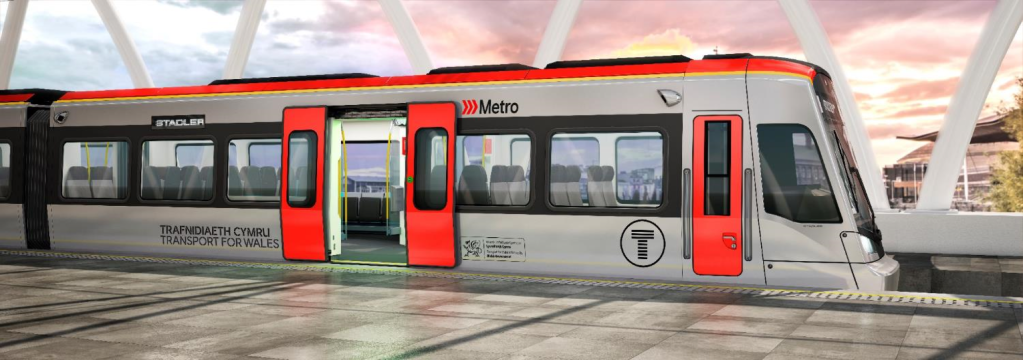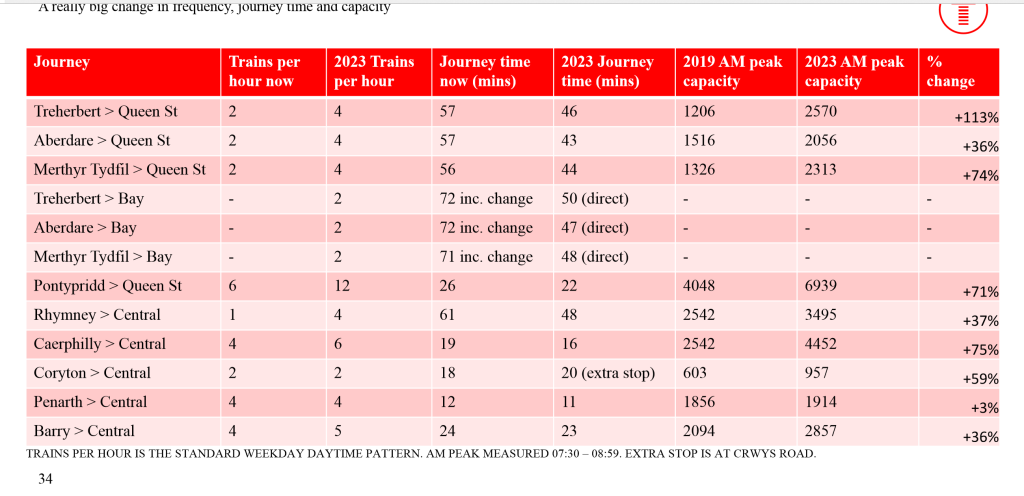There has been quite a bit of debate this last week as regards the provision of toilets on the new tram-trains planned on the South Wales Metro for the services through Pontypridd to Cardiff. I thought I’d add to the conversation…. (I have also added a note at the end on journey time and stats!)
First let’s look at some facts….
Today, old pacer and other train stock operate on the valley lines and most fall foul of legal requirement to comply with new “Persons of Reduced Mobility “(PRM) law by the beginning of 2020. It’s clearly not acceptable and has resulted in some passengers at worst not being able to use the trains at all, or at best, having a pretty poor travel experience. Transport for Wales (TfW) know this and have been busy trying to upgrade stock and secure new trains to satisfy these requirements in advance of the new fleet arriving from 2022/3.
Current services from Merthyr, Aberdare Treherbert typically take an hour to reach Cardiff with at best 2 trains an hour. There is no level boarding (so no easy wheelchair access) and most stations do not have toilets. Yes, the trains do have toilets – but sometimes these are locked if there are faults. In fact after a journey from home, say in Dowlais, to Merthyr station you could be waiting up to a further half an hour for a train at a station with no toilets at all, the same is true of Aberdare I believe, and most of the stations on the valley lines.
When engaged in transport planning one has to weigh up and assess a wide range of costs and benefits and reflect the needs of current and potential passengers. These factors include congestion, demand, capacity, PRM compliance, station design, service frequency and yes, costs – both capital and revenue.
Choices always have to be made and transport planners do their best to deliver the most value to most people; they also have to asses a range of alternative measures to deliver the same outputs.
For example, do you invest in level boarding at every station to reduce barriers to wheelchair access to trains and in more fully accessible toilets at most stations along the line, or do you invest in toilets in every vehicle and thereby reduce network capacity (preventing more people from travelling ) as well as adding to operating costs. I am not saying what is right or wrong – but there are always choices and these choices are influenced by the type of service, journey and its length.
When addressing these questions in respect of the valley lines, we should be doing so with reference to services we will be getting in future – not what we have today!
When Metro is operating by 2023/4 – new tram-trains will run from Merthyr, Aberdare and Treherbert to Cardiff Central and Cardiff Bay. With maximum journey times of the order 45-50 minutes and frequencies of 4tph from the HoV with 12tph through Pontypridd (which itself will only 22 minutes from Cardiff), it will be a completely different experience from that endured today. All vehicles will be designed for level boarding and stations will be upgraded, many more with fully accessible toilets so that no-one is more than 15 minutes from a toilet. I would argue that people often spend longer getting to/from the station.
And to be clear all other trains being procured as part of the W&B franchise will have toilets – including, the tri-modes operating on the Rhymney Line from Rhymney to the Vale of Glamorgan.
So, no-one, as the headlines have suggested in the last few days, will be traveling on services longer than an hour. The maximum as set out above is about 50 minutes and the vast majority of people will have station to station journeys of 30 minutes or less. This is not at all like intercity or regional rail services.

Figure 1 TfW Tram-train LR Metro Vehicle for South Wales Metro

Figure 2 Metro Services (from TfWRail presentation 2018)
I appreciate the concerns, they are valid – but choices have to be made with finite resources.
The core of the South Wales Metro is being designed and operated as a high capacity, high frequency urban transit system. In that respect it is very much like the Manchester Metrolink (similar demographic and socio-economic catchment) the Croydon Tramlink, Tyne and Wear Metro and even London Underground. None of those system have toilets and many of them offer services with longer journey times than those proposed for the tram-trains. Even some of Cardiff Bus services from the periphery of the city will have similar or longer journey times to the centre of Cardiff than from Aberdare for example. In fact, the vast majority of local bus services offer no toilet facilities and of course, no car journeys do at all.
In essence what is proposed for the core valleys through Pontypridd is best practice for “light rail systems” and will be fully PRM compliant so that no-one will be prevented from using rail services to visit family or friends, go to hospital, get to work or for leisure.
I believe TfW did consult and engage the views of groups like Disability Wales, RNIB, Age UK, MIND, Action on Hearing Loss and many others. Furthermore, during the procurement, the bidders would have presented their solution to some of these groups via the Public Transport Users Advisory Panel and the Accessible Transport Panel. None of what is proposed should be a surprise or is without precedent for similar public transport systems. I also think the commitment to enhance our stations with accessible features will actually set our services apart from many others, for example in Manchester or Croydon.
I think the issue of toilets on trains has been misrepresented with little mention of the overall plan to deliver widescale accessibility improvements which will make the metro a far more inclusive, comfortable and stress-free mode of travel than it is currently is today for some passengers. Overall the system will provide more and faster services that everyone can access, more passenger facilities and be far more PRM compliant than the system that exists today.
Finally in respect of the match day debacle – well that’s an issue now already. A train full of say 250 people with full bladders are not likely to be satisfied with one toilet! Surely much better to use large scale and perhaps temporary facilities at key stations irrespective of whether there is a toilet on the train or tram-train? Finally, if the population of SE Wales are uniquely unable to comply with accepted norms of toilet behaviour, I would seriously consider using CCTV and dish out heavy fines.
I hope this helps better frame the current discussions.
Thanks also to Katie Allister for helping to refine this article
Post Script November 2019
I thought a few more notes might help in response to a recent article challenging my analysis…
That article quoted the DfT Light Rail (LR) stats and used average journey lengths for LR Systems and quoted figures for two systems, the Croydon Tramlink and Docklands Light Railway (DLR), with average lengths of 3.3 miles. The article then went on to compare that figure with the actual distance from Treherbert to Cardiff (which to Queen Street is about 22 miles)
Well you can’t compare an average with an absolute if you want draw any meaningful conclusions; the systems selected were not the best comparison with the South Wales Metro (Manchester Metrolink or London Underground much better) and the variable that is important is time, not distance; and it is absolute time, not an average over all passenger journeys, that is important.
So here are some more stats…..you can draw your own conclusions.
About 60% of the demand on the valleys lines to/from Merthyr, Treherbert and Aberdare to Cardiff is generated by Pontypridd and stations further south – you can get details from ORRs station usage stats. This suggests an average journey length for those services of the order of 15-18km (or about 20 mins once the new metro services are operating). In fact I know anecdotally that many trips on the Rhondda branch are shorter than other branches and make up less than 20% of the total.
In comparison the average journey lenghth on the Metrolink is 10KM.
Once Metro is operating there will be four services an hour taking 46 mins to reach Cardiff Queen Street from Treherbert with a number of stations on route having toilets so no one is more than 15 mins from a toilet. Overall capacity on these services will more than double.
As a comparison here are some journey times from London Underground and Manchester Metrolink ( and these are not the longest by any means) through stations that have no toilets (as far as I know).
On the Metrolink’s Rochdale Line, Newbold to Victoria Station is 42 mins and Wythenshawe Town Centre to Market St 47 minutes.
On London Underground, Upminster to Embankment is 44 minutes and Epping to Tottenham Court Rd 47 minutes. There are many journeys much longer than this, especially with changes often required for a full “end to end” trip.
On the DLR Becton to Bank is 32 mins and Beckenham to Wimbledon on the Croydon Tramlink is 53 minutes.
I could go on. The key message is that if you are going to use statistics you have to compare like for like. As I said there are always choices and for the South Wales Metro and the use of LR tram-trains, what is proposed is entirely normal and consistent with similar systems.
In my view a much better use of everyones time is thinking about the next phases of Metro without being constrained by local authority or constituency boundaries. For the valleys seems to me a x-valley service linking Terherbert to Blackwood via Pontypridd would be a better focus for any petition!

RE: stations with toilets being placed at regular intervals – seems this information would be useful to incorporate in e.g. on-board line diagrams or some other such information.
LikeLike
Having worked as a Guard and Driver for many years on the Valleys, i find the rose tinted specticle wearing none railway Peoples view of our,the railway worker s world quite sad. The toilets Will be vandalised. Train’s Will be delayed And canceled. And the railway utopia you speak of will never be achieved.
LikeLike